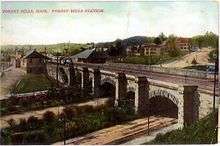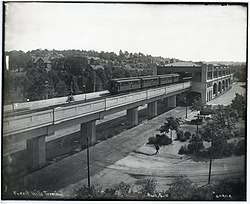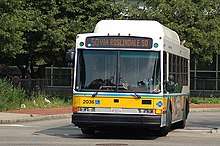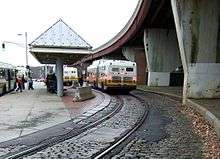Forest Hills station (MBTA)
Forest Hills is an intermodal transfer station in Boston, Massachusetts. It serves the MBTA's rapid transit Orange Line, MBTA Commuter Rail's Needham Line, and is a major terminus for MBTA bus routes. It is located in Forest Hills, in the southern part of the Jamaica Plain neighborhood. The Providence/Stoughton Line and Franklin Line, as well as Amtrak's Acela Express and Northeast Regional trains, pass through the station without stopping.
Forest Hills | ||||||||||||||||
|---|---|---|---|---|---|---|---|---|---|---|---|---|---|---|---|---|
 Aerial view of Forest Hills station in 2018 | ||||||||||||||||
| Location | Washington Street at Hyde Park Avenue Jamaica Plain, Boston, Massachusetts | |||||||||||||||
| Coordinates | 42°18′03″N 71°06′51″W | |||||||||||||||
| Line(s) | Northeast Corridor (Southwest Corridor) | |||||||||||||||
| Platforms | 2 island platforms (1 for each service) | |||||||||||||||
| Tracks | 2 (Orange Line) 4 (commuter rail) | |||||||||||||||
| Connections | ||||||||||||||||
| Construction | ||||||||||||||||
| Parking | 206 spaces ($6.00 fee) 5 accessible spaces | |||||||||||||||
| Bicycle facilities | 32 spaces ("Pedal and Park" bicycle cage) | |||||||||||||||
| Disabled access | Yes | |||||||||||||||
| Other information | ||||||||||||||||
| Fare zone | 1A (Commuter Rail) | |||||||||||||||
| History | ||||||||||||||||
| Opened | 1842 (commuter rail station) November 22, 1909 (elevated rapid transit station) | |||||||||||||||
| Rebuilt | May 4, 1987 (modern combined station) | |||||||||||||||
| Previous names | Tollgate | |||||||||||||||
| Traffic | ||||||||||||||||
| Passengers (FY2019) | 12,538[1] (Orange Line weekday average) | |||||||||||||||
| Passengers (2018) | 142[2] (Needham Line weekday average) | |||||||||||||||
| Services | ||||||||||||||||
| ||||||||||||||||
The station is surrounded by large parks. To the west of the station is Harvard University's Arnold Arboretum, part of Boston's Emerald Necklace; to the east are the Forest Hills Cemetery and Franklin Park, another part of Boston's Emerald Necklace. The station also marks the southern end of the linear Southwest Corridor Park, built over and around the Southwest Corridor (which carries Amtrak, commuter rail, and Orange Line trains into the center of Boston).
Several small retailers are located in the station, including a doughnut/coffee shop, newspaper stand and florist. During warmer months, a farmers' stand is set up. In addition, the station features an MBTA Police substation. Park and ride parking spaces for 206 cars are available on the station grounds. Overnight parking is not allowed.
Forest Hills station is fully accessible on all modes.
History



Tollgate station
The Boston and Providence Railroad (B&P) was chartered on June 22, 1831 to build a rail line between its two namesake cities. Construction began in late 1832, and the B&P opened from Park Square, Boston to Canton in 1834.[3]:29 The remaining section of the B&P main line from Canton to Providence opened the following year with the completion of the Canton Viaduct. The B&P, like many early railroads, was primarily intended for intercity travel; the only intermediate stations north of Canton were at Dedham Plain (later called Readville) and Pierpont Village (later called Roxbury Crossing).[4]:8
Two additional stations in Jamaica Plain were added in 1842: Jamaica Plain at Green Street, and Tollgate where the line crossed the Norfolk and Bristol Turnpike adjacent to one of its toll gates.[4] The B&P began regularly running Dedham Specials (which used the main line to Readville and the Dedham Branch to Dedham station) in June 1842, which made commuting from Tollgate and the other intermediate stations possible.[3]:29 A second track from Roxbury Crossing to Readville was added in 1845.[3]:31 A small station building at Tollgate was added that year, and several businesses soon sprung up around the station.[4]
On June 3, 1850, the B&P opened a second branch to Dedham – this one from Tollgate via West Roxbury.[3]:29 Commuter traffic on the B&P – which had numbered just 320 daily passengers from the eight stations north of Readville in 1849 – was rapidly expanding.[5][6] The railroad cut sharply into the profits of the private turnpike; it became a free public road south of Dedham in 1843, and north of Dedham in 1857.[4]:9 Although the station and surrounding village retained the name "Tollgate" for some time, by the 1870s they were called Forest Hills after the Forest Hills Cemetery, which was founded nearby in 1848.[4]:14[7]
Horsecars and streetcars
The railroad would soon face its own competition in the form of horsecar lines. The West Roxbury Railroad opened from South Street at McBride Street in Jamaica Plain (1,900 feet (580 m) north of Forest Hills station) to Roxbury Crossing in 1857. It was immediately acquired by the Metropolitan Railroad and connected to its existing trackage, providing service from Jamaica Plain to downtown Boston.[8]:60 After the former Turnpike (soon renamed Washington Street) became a free public road in 1857, a horsecar line was constructed on it between Tollgate and existing tracks at Dudley Square.[4]:10
Most horsecar service in Boston was consolidated under the West End Street Railway in 1887.[8]:8 Electric streetcar service in Boston began with the Beacon Street line in 1888; the Washington Street line was electrified on September 2, 1890.[4]:11 The West End built its first Forest Hills Yard (renamed Arborway Yard in 1924) in 1895.[4]:34 The West End was acquired by the Boston Elevated Railway (BERy) in 1897.[8]:35 The line on South Street was extended to Forest Hills Yard in 1902; through service to the Tremont Street subway on the Arborway Line began in 1915.[8]:61 The Washington Street and South Street lines converged at Forest Hills Square, just east of the station; a covered platform was built there to aid transfers.[4]:11
Raising the railroad
Between 1891 and 1897, the New Haven Railroad raised its main line from just south of Back Bay to Forest Hills onto a 4-track stone embankment to eliminate dangerous grade crossings. The Forest Hills viaduct was designed by Frederick Law Olmsted as an important element of the Emerald Necklace. Five new local stations in Dorchester and Jamaica, including Forest Hills, opened on June 1, 1897.[9] The station building at Forest Hills was similar to the still-extant station at Norwood Central, built two years later.[10]
Elevated station
On November 22, 1909, the Washington Street Elevated was extended from Dudley Square to Forest Hills, with a grand elevated station and a maintenance facility located between Hyde Park Avenue and the mainline tracks.[11] As with most Boston Elevated Railway stations, Forest Hills was designed for efficient streetcar-to-elevated transfers; Forest Hills and nearby Arborway became major streetcar hubs. Designed by Edmund M. Wheelwright, the station was called "the chef-d'œuvre of rapid transit development in Boston".[12]
The New Haven Railroad briefly operated high-frequency local service from Forest Hills to South Station, but it failed to compete with the El and was cut back. The five local stops were abandoned on September 29, 1940.[9] The Forest Hills stop alone was revived in June 1973 for Needham Line service, although by 1976 it was used by less than 50 riders a day, versus 15,000 at the Elevated station.[11][13]
Southwest Corridor
From 1979 to 1987, Forest Hills was completely rebuilt as an intermodal transfer station as part of the Southwest Corridor project. The project involved removing the century-old viaduct and moving the tracks into a trench with three mainline tracks plus two Orange Line tracks to replace the aging Washington Street Elevated. The new rapid transit stations mirror the locations of the former mainline stations between Forest Hills and Back Bay. Needham Line service was suspended on October 13, 1979; Providence/Stoughton Line and Franklin Line service (which do not stop) were rerouted over the Fairmount Line on November 3, 1979.[11] The Forest Hills viaduct was destroyed with a controlled explosion on November 12, 1983; work on the new station began on June 1, 1984.[14]
The $38 million station, designed by Cambridge Seven Associates, was constructed of brick, steel and glass; it was meant to resemble a greenhouse to fit in with the surrounding parks. The station's $120,000 clock tower has become a local landmark; it is mirrored by four interior clocks.[14][15][16] Orange Line service on the El ended on May 4, 1987, and began on the Southwest Corridor on May 7. The corridor reopened to commuter rail and Amtrak on October 5, 1987, though Needham Line service did not resume until October 19.[11]
The new station included streetcar loops on the north end of the station for the relocated Arborway station, also signed as "Forest Hills", to allow closer connections than were available at Arborway. The small station included waiting shelters, maps and a turnaround loop. On December 28, 1985, the Arborway Line (Green Line E branch) service was "temporarily" suspended while construction work was performed in the Huntington Avenue subway. Service was restored to Brigham Circle on July 26, 1986 and Heath Street on November 4, 1989.[11] However, service was never restored to Forest Hills due to the MBTA's objection to running streetcars in mixed traffic. Restoration of Green Line trolley service to Arborway was part of air pollution remediation promised for the Big Dig, but a lawsuit mandating the return of service was defeated in court in January 2011, nullifying plans to restore service.[17]
A bicycle cage – the first MBTA "Pedal and Park" cage in Boston – opened at Forest Hills on September 28, 2009.[18] Work performed as part of the Casey Overpass removal, which began in 2015, involved a rebuilt upper busway and a second Orange Line headhouse.[19] The canopy was constructed as a $11 million change order to the Arborway project.[20] The never-used Green Line loops and waiting area near the north entrance to Forest Hills were demolished.[21] The headhouse opened on November 6, 2019.[20] The three older elevators will be replaced, and a new elevator added to connect the two busways, beginning in 2022.[22]
Station layout
Orange Line trains use both tracks; a crossover north of the platforms allows trains to switch tracks for regular right-hand drive operation on the rest of the line. Needham Line trains primarily use Track 5 which leads directly to the branch, but may also use Track 3. Passing commuter rail trains use tracks 3, 1, and 2; Amtrak trains generally use tracks 1 and 2 because Track 3 was not originally electrified.
| G | Street level | Exit/entrance, station house, buses, parking |
| M | Mezzanine | Orange Line fare control |
| P Platform level |
Track 2 | Orange Line toward Oak Grove (Green Street) → ← Orange Line termination track |
| Island platform | ||
| Track 1 | Orange Line toward Oak Grove (Green Street) → ← Orange Line termination track | |
| Track 5 | ← Needham Line toward Needham Heights (Roslindale Village) Needham Line toward South Station (Ruggles) → | |
| Island platform | ||
| Track 3 | ← Providence/Stoughton Line, Franklin Line do not stop here | |
| Track 1 | ← Amtrak services, Providence/Stoughton Line, Franklin Line do not stop here → | |
| Track 2 | Amtrak services, Providence/Stoughton Line, Franklin Line do not stop here → | |
Bus connections


Forest Hills serves as a major bus transfer station; 16 MBTA bus routes terminate at the station. Routes 16, 21, 31, 32, and 42 run on Hyde Park Avenue, Washington Street (north of the station), and the Arborway, and use the lower busway located off Hyde Park Avenue east of the station. The remaining nine routes run on South Street and Washington Street; they use the upper busway west of the station.
Route 39 buses formerly used loops off New Washington Street built for Green Line E branch streetcar service in the 1980s but never used as such. On October 14, 2017, it was permanently rerouted to the upper busway during removal of the Casey Overpass.[23]
- 16: Forest Hills station–Andrew station or Harbor Point
- 21: Ashmont station–Forest Hills station
- 30: Mattapan station–Forest Hills station via Cummins Highway and Roslindale Square
- 31: Mattapan station–Forest Hills station via Morton Street
- 32: Wolcott or Cleary Square–Forest Hills station
- 34: Dedham Line or Dedham Mall–Forest Hills station
- 34E: Walpole Center–Forest Hills station
- 35: Dedham Mall or Stimson Street–Forest Hills station
- 36: Millennium Park or VA Hospital–Forest Hills station
- 37: Baker Street & Vermont Street–Forest Hills station
- 38: Wren Street–Forest Hills station
- 39: Forest Hills station–Back Bay station
- 40: Georgetowne station–Forest Hills
- 42: Forest Hills station–Nubian station
- 50: Cleary Square–Forest Hills station
- 51: Reservoir station–Forest Hills station
Route 192, a single early-morning trip intended for fare collectors but open to the general public, also stops at Forest Hills.
References
- "A Guide to Ridership Data". MassDOT/MBTA Office of Performance Management and Innovation. June 22, 2020. p. 6.
- Central Transportation Planning Staff (2019). "2018 Commuter Rail Counts". Massachusetts Bay Transportation Authority.
- Humphrey, Thomas J.; Clark, Norton D. (1985). Boston's Commuter Rail: The First 150 Years. Boston Street Railway Association. pp. 29–37. ISBN 9780685412947.
- Heath, Richard (May 16, 2013). "A History of Forest Hills" (PDF). Jamaica Plain Historical Society.
- Report of the Committee for Investigating the Affairs of the Boston and Providence Railroad Corporation. J. H. Eastburn's Press. January 9, 1856. p. 4 – via Internet Archive.
- von Hoffman, Alexander (1996). Local Attachments: The Making of an American Urban Neighborhood, 1850 to 1920. Johns Hopkins University Press. p. 14. ISBN 0801853931.
- Outline and Index Map of West Roxbury. Atlas of County of Suffolk, MA. G.M. Hopkins & Co. 1874 – via Ward Maps.
- Clarke, Bradley H.; Cummings, O.R. (1997). Tremont Street Subway: A Century of Public Service. Boston Street Railway Association. ISBN 0938315048.
- Rocheleau, Matt (26 November 2012). "Raising the railroad in Forest Hills". Boston Globe. Retrieved 8 August 2014.
- Roy, John H. Jr. (2007). A Field Guide to Southern New England Railroad Depots and Freight Houses. Branch Line Press. pp. 210–211. ISBN 9780942147087.
- Belcher, Jonathan. "Changes to Transit Service in the MBTA district" (PDF). NETransit.
- Coburn, Frederick W. (November 1910). "Rapid Transit and Civic Beauty". New Boston. Vol. 1 no. 7. pp. 307–314 – via Google Books.
- Massachusetts Executive Office of Transportation and Construction (22 April 1976). Capital needs developed at the corridor level: core and west (Report). Massachusetts Executive Office of Transportation and Construction. p. 102.
- Rocheleau, Matt (3 December 2012). "History time: Southwest Corridor Park". Boston Globe. Retrieved 8 August 2014.
- "MBTA Forest Hills Station". Cambridge Seven Associates. Archived from the original on September 23, 2015.
- Shand-Tucci, Douglass (1999). Built in Boston: City and Suburb, 1800–2000. University of Massachusetts Press. p. 319. ISBN 9781558492011 – via Google Books.
- Ruch, John (26 August 2011). "Trolley comeback killed by court". Jamaica Plain Gazette. Retrieved 19 February 2013.
- "Transportation Officials Announce T's First Bike Cage In Boston" (Press release). Massachusetts Bay Transportation Authority. September 28, 2009.
- "Casey Arborway Project: Casey Overpass Permanent Closure" (Press release). Massachusetts Department of Transportation. May 5, 2015.
- "General Manager's Remarks" (PDF). Massachusetts Bay Transportation Authority. November 4, 2019.
- Brelsford, Laura (December 5, 2016). "MBTA System-Wide Accessibility Initiatives: December 2016 Update" (PDF). Massachusetts Bay Transportation Authority Department of System-Wide Accessibility. p. 22.
- Brelsford, Laura (November 26, 2019). "SWA Initiatives—November 2019" (PDF).
- Jessen, Klark (October 10, 2017). "Casey Arborway: MBTA Route 39 Bus Moves to Upper Busway October 14". MassDOT Blog (Press release).
External links
| Wikimedia Commons has media related to Forest Hills station (MBTA). |